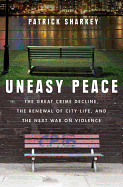
According to Crime Lab New York scientific director Patrick Sharkey, there was an uptick in homicides in the United States beginning in the second half of the 1960s. In the 1990s, criminologists were prophesying doom. Then something unexpected happened: the nation's homicide rate started to decline. In fact, 2014--the year Sharkey began to write Uneasy Peace: The Great Crime Decline, the Renewal of City Life, and the Next War on Violence--was "not only the safest year of the past five decades, it was one of the safest years in U.S. history."
What happened? Gentrification played a part, but Sharkey admits an inconvenient truth for social liberals: mass incarceration was a big factor in the reduction in crime. It wasn't just that more lockups meant less danger to residents of poor urban neighborhoods: less "predator stress" in children's lives led to, for example, measuredly better academic performance. But it's also true that racially biased police strategies had a hand in the crime drop.
Sharkey, a social scientist who wrote a previous book on neighborhood inequality, argues for proven methods to reduce violence that don't infringe on civil rights: collecting and working from data, establishing "urban guardians," and reshaping the relationship between the police and those they serve. Painstakingly researched and deeply compassionate, Uneasy Peace is a natural companion to Matt Taibbi's I Can't Breathe: A Killing on Bay Street--about Eric Garner, the black man who died during an overzealous application of broken-windows-theory policing--a devastating example of the "uneasy" in Sharkey's title. --Nell Beram, freelance writer and author

